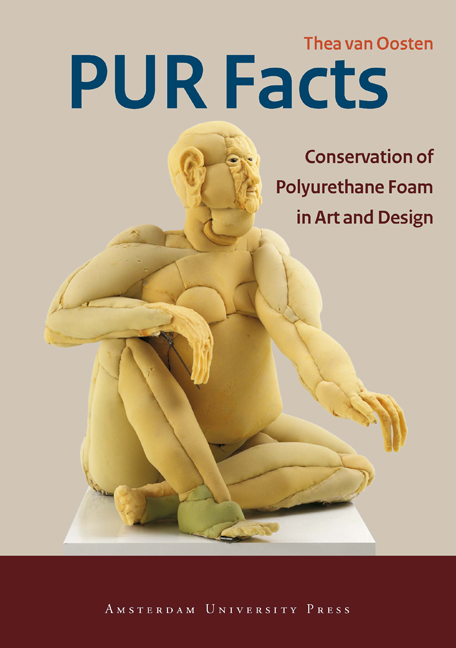Book contents
- Frontmatter
- Contents
- Preface
- Introduction
- 1 Polyurethanes, Manufacture and Applications
- 2 Chemistry, Properties and Degradation
- 3 History of Polyurethane foam Conservation
- 4 Ageing Behaviour of Polyurethane foam
- 5 Assessing the Condition of Polyurethane foam
- 6 Case Studies
- Acknowledgements
- Glossary
- General Information
- Bibliography
3 - History of Polyurethane foam Conservation
Published online by Cambridge University Press: 14 January 2021
- Frontmatter
- Contents
- Preface
- Introduction
- 1 Polyurethanes, Manufacture and Applications
- 2 Chemistry, Properties and Degradation
- 3 History of Polyurethane foam Conservation
- 4 Ageing Behaviour of Polyurethane foam
- 5 Assessing the Condition of Polyurethane foam
- 6 Case Studies
- Acknowledgements
- Glossary
- General Information
- Bibliography
Summary
Introduction
Ever since polyurethane foams first became available, artists have had a great appreciation for this ‘new’ material. Nowadays, we find ourselves confronted with the limited durability of the early polyurethane ether and ester foams: loss of resilience, cracking, crumbling and powdering.
From 1990 onwards, conservators carried out consolidation of flexible PUR foam using various consolidating agents as a curative method on degraded objects, thus expecting to slow down or inhibit degradation.
As long as polyurethane foam has not lost its structural integrity, objects can in some cases be restored using traditional techniques that have proven their suitability and are reversible. Objects that have degraded to such an extent that they will soon lose their significance require invasive treatment. For these objects there is simply no time to wait for a better form of treatment because the condition of the foam is so bad that the object will soon cease to exist altogether. Reversibility is not an issue when the chosen method is essentially a last resort. In this chapter conservation treatments are categorised alphabetically and chronologically according to the consolidants and adhesives used (Table 2).
(1990, 1992, 1997). One of the first research studies into the consolidation of objects of cultural heritage using plastic polymers was a work by David Grattan dating from 1990. He researched the possibility of consolidating degrading objects with Parylene by graft polymerisation. In 1992, this line of research was continued by Malcolm Bilz, who investigated the possibilities of restoring a foamed work of art by Marcel Breuer. In 1997 Lisa Nilson performed tests with Parylene. However, this irreversible method, which takes place under vacuum, is limited by the fact that the vacuum chamber only allows rather small objects to be consolidated. Moreover, vacuuming is often inappropriate for cultural heritage objects.
(1994/1995). Brenda Keneghan researched ‘Larry the Lamb’, a foam figure of the children's storybook character from the collection of the Bethnal Green Museum of Childhood in London (Figure 11). The animation polyure thane foam puppets were made between 1975 and 1978. The puppets that had been painted were best conserved because their coating had restricted the entry of light and oxygen and hence slowed down photo-oxidation.
- Type
- Chapter
- Information
- PUR FactsConservation of Polyurethane Foam in Art and Design, pp. 47 - 56Publisher: Amsterdam University PressPrint publication year: 2011



